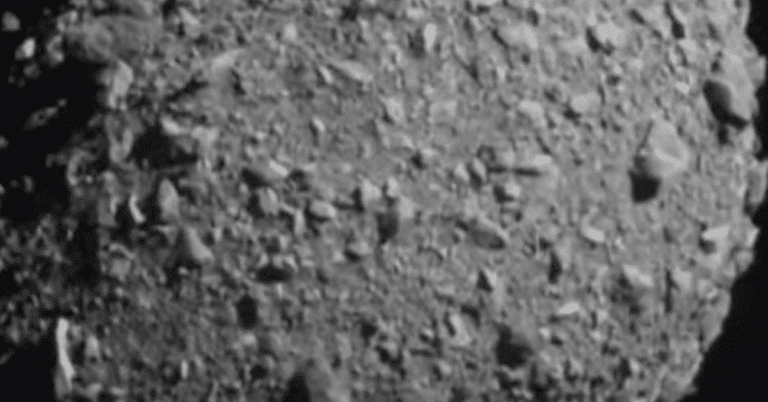
[ad_1]
A NASA spacecraft slammed into the surface of a distant asteroid at 7:14PM ET on Monday night, the climax of the agency’s Double Asteroid Redirection Test (DART).
An hour before impact, the target asteroid, Dimorphos, wasn’t even visible in the images from the spacecraft. In some of the early images sent back to Earth, even Dimorphos’ larger companion Didymos, looked like a single speck against a sea of black. The DART spacecraft was moving at 14,000 miles per hour, and details quickly came into view. Viewers on Earth saw the rough surface of Didymos zip by as the spacecraft cruised autonomously towards Dimorphos. Boulders filled the screen just before it went bright red, indicating a loss of signal — DART had reached its final destination.
In the mission operations room, there was wonderment as the images came in. “This asteroid was coming into the field of view for the first time, we really had no idea what to expect. We didn’t really know the shape of the asteroid, but we knew where we’re going to hit.” said Elena Adams, DART Mission Systems Engineer. “So I think all of us were kind of holding our breath. I’m kind of surprised none of us passed out actually, for a second there.“
Telescopes around the world (and a few in space!) are now turning their attention to the scene of the collision. They’ll be watching to see how much the impact changed the movement of Dimorphos. The crash is part of the first practical planetary defense experiment — a trial to see if humanity might one day be able to redirect the path of an asteroid headed toward our planet.
“We’re embarking on a new era of humankind, an era in which we potentially have the capability to protect ourselves from something like a dangerous hazardous asteroid impact. What an amazing thing. We’ve never had that capability before.“ said Lori Glaze, Director of NASA’s Planetary Science Division, soon after the impact.
To be clear, neither Dimorphos nor Didymos, pose any danger to Earth. No known asteroids pose a significant and immediate threat to our planet. But NASA is playing a long game. Someday in the future, if an asteroid is spotted on a dangerous path, the agency wants us to have options that could let us avert catastrophe.
The option that DART is testing is one of the most direct; if we slam something into an asteroid, will it change how that asteroid moves? Because Dimorphos’ orbit takes it between another asteroid (Didymos) and Earth, researchers will soon have an answer to that question.
Dimorphos is relatively small, so scientists couldn’t actually see the asteroid until just before the collision. But telescopes can see Didymos dimming every time that Dimorphos crosses between it and Earth. This lets researchers know how fast the asteroid is moving. They expect to see Dimorphos’ orbit speed up after the collision, but how closely the asteroid’s behavior will match the computer models remains to be seen.
It will likely take a few months to get a full answer of how much the DART mission changed Dimorphos’ orbit, but some images and data will likely start coming out in the next few days and weeks from sources all around the solar system.
Before impact, the DART spacecraft released a smaller satellite, the Italian-built LICIACube. This tiny spacecraft followed DART on its way to its doom, taking pictures of the immediate aftermath, which will be sent back to researchers on Earth. Telescopes on seven continents will also focus on the asteroid system, as will the Lucy spacecraft, the James Webb Space Telescope, and the Hubble space telescope. Then, in 2024, the European Space Agency will send another spacecraft to survey Dimorphos, and get a close-up look at the asteroid and whatever rubble remains of the spacecraft itself.
But in the meantime, the last images from the spacecraft offer a wealth of tantalizing details for researchers, including Carolyn Ernst, a scientist working on DART’s imaging system, DRACO. At a press conference after the impact, she extolled the surprising shapes of the asteroid pair, and the boulders, smooth spots and craters of Didymos, visible for only a brief time.
“These guys, their job is done.” Ernst said, referring to her engineering colleagues, “But ours is just beginning,”
[ad_2]